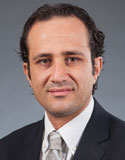Video courtesy of medpageTODAY.A recent study found that taking a broader approach to treat ventricular arrhythmias with cardiac ablation resulted in lower recurrence rates, re-hospitalizations, and deaths. The study, presented by Dr. Luigi Di Biase and colleagues, compared substrate-based ablation (in which all damaged areas of the lower heart muscle are treated) to ablation of clinical ventricular tachycardia (in which the origin of the abnormal rhythm is pinpointed, then the target tissue is scarred with electrical current).
According to the National Heart, Lung, and Blood Institute, 250,000-450,000 adults in America each year experience sudden cardiac arrest (SCA), and most these cases are caused by cardiac arrhythmias, particularly ventricular tachycardia and ventricular fibrillation.

Luigi Di Biase, MD, PhDThe minimal radiofrequency catheter ablation procedure, which cauterizes and destroys areas of the heart muscle responsible for the arrhythmia, has been highly effective in restoring cardiac sinus rhythm. However, during ablation of clinical ventricular tachycardia, the physician must induce ventricular tachycardia by stimulating the heart muscle in order to identify the area(s) in need of cauterization. The trial’s substrate-based ablation technique, however, targets all areas of abnormal potential with 3D mapping, which noninvasively creates a full picture of the heart and identifies areas of scar with abnormal electrical conduction.
The study was conducted at seven centers on a total of 118 patients with clinical stable ventricular tachycardia (rapid heartbeat originating from the lower chambers) and ischemic cardiomyopathy (decreased blood supply due to an enlarged, weak left ventricle). Sixty patients were randomly assigned to minimal ablation and 58 to substrate-based ablation. Results of the trial revealed the following:
- Researchers were unable to induce clinical ventricular tachyarrhythmia in any of the patients at the end of the procedure.
- Patients who underwent the substrate-based ablation were significantly less likely to have a recurrent VT during the following 12 months..
- Patients who underwent the substrate-based ablation were significantly less likely to be re-hospitalized (12%, vs. 32% of the minimal ablation group)..
- Patients who underwent the substrate-based ablation had a slightly lower risk of death (8%, vs. 15% of the minimal ablation group), and a few of their deaths were arrhythmia related.
"This is the first randomized study that compared these two techniques,” said Dr. Andrea Natale, principal investigator and world renowned electrophysiologist.
"Substrate ablation in sinus rhythm was more effective, faster and easier than ablating during tachycardia," said Dr. Di Biase, Associate Professor of Medicine (Cardiology) at Albert Einstein College of Medicine/Montefiore Medical Center and Senior Researcher at Texas Cardiac Arrhythmia Institute at St. David’s Medical Center in Austin, Texas.
The study originated from a series of previous investigations that had uncovered a superiority of substrate-based ablation over clinical ventricular tachycardia ablation alone. In 2012, Drs. Di Biase and Natale published one of the first series ever on this approach in the Journal of the American College of Cardiology.
"We believe that this study will give clinical evidence to allow more physicians to test this approach," said Dr. Di Biase.
Posted August 21, 2014